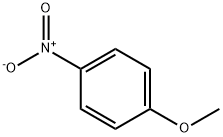CHEMICAL AND PHYSICAL PROPERTIES
| Physical Description | Nitroanisole appears as a light red or amber-colored liquid or crystals. Insoluble in water and denser than water. Contact may irritate skin, eyes and mucous membranes. May be toxic by ingestion, inhalation or skin absorption. Used to make other chemicals. |
|---|---|
| Boiling Point | 531 °F at 760 mmHg (NTP, 1992) |
| Melting Point | 48.9 °F (NTP, 1992) |
| Flash Point | greater than 230 °F (NTP, 1992) |
| Solubility | less than 1 mg/mL at 75 °F (NTP, 1992) |
| Density | 1.254 at 68 °F (NTP, 1992) - Denser than water; will sink |
| Vapor Pressure | 1 mmHg at 127 °F ; 18.5 mmHg at 167 °F; 30.0 mmHg at 194 °F (NTP, 1992) |
| Kovats Retention Index | 1414 1424.3 1463 |
| Chemical Classes | Nitrogen Compounds -> Other Aromatics (Nitrogen) |
SAFETY INFORMATION
| Signal word | Warning |
|---|---|
| Pictogram(s) |
 Health Hazard GHS08 |
| GHS Hazard Statements |
H351:Carcinogenicity H412:Hazardous to the aquatic environment, long-term hazard |
| Precautionary Statement Codes |
P202:Do not handle until all safety precautions have been read and understood. P273:Avoid release to the environment. P280:Wear protective gloves/protective clothing/eye protection/face protection. P308+P313:IF exposed or concerned: Get medical advice/attention. P405:Store locked up. P501:Dispose of contents/container to..… |
COMPUTED DESCRIPTORS
| Molecular Weight | 153.14 g/mol |
|---|---|
| XLogP3 | 2 |
| Hydrogen Bond Donor Count | 0 |
| Hydrogen Bond Acceptor Count | 3 |
| Rotatable Bond Count | 1 |
| Exact Mass | 153.042593085 g/mol |
| Monoisotopic Mass | 153.042593085 g/mol |
| Topological Polar Surface Area | 55 Ų |
| Heavy Atom Count | 11 |
| Formal Charge | 0 |
| Complexity | 135 |
| Isotope Atom Count | 0 |
| Defined Atom Stereocenter Count | 0 |
| Undefined Atom Stereocenter Count | 0 |
| Defined Bond Stereocenter Count | 0 |
| Undefined Bond Stereocenter Count | 0 |
| Covalently-Bonded Unit Count | 1 |
| Compound Is Canonicalized | Yes |
PRODUCT INTRODUCTION
description
Nitroanisole appears as a light red or amber-colored liquid or crystals. Insoluble in water and denser than water. Contact may irritate skin, eyes and mucous membranes. May be toxic by ingestion, inhalation or skin absorption. Used to make other chemicals.
